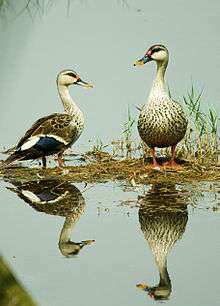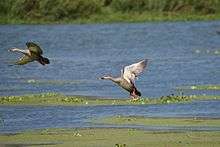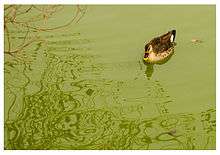Spot-billed duck
| Spot-billed duck | |
|---|---|
 | |
| Indian spot-billed duck (A. p. poecilorhyncha) | |
| Scientific classification | |
| Kingdom: | Animalia |
| Phylum: | Chordata |
| Class: | Aves |
| Order: | Anseriformes |
| Family: | Anatidae |
| Subfamily: | Anatinae |
| Genus: | Anas |
| Species: | A. poecilorhyncha |
| Binomial name | |
| Anas poecilorhyncha Forster, 1781 | |
| Subspecies | |
| |

The spot-billed duck (Anas poecilorhyncha) sometimes referred to as the spotbill, is a dabbling duck which breeds in tropical and eastern Asia. It has three populations, treated here as subspecies, the Indian spot-billed duck (A. poecilorhyncha poecilorhyncha), Eastern spot-billed duck (A. poecilorhyncha zonorhyncha), and Burmese spot-billed duck (A. poecilorhyncha haringtoni). Some authors elevate the eastern population as a species, Anas zonorhyncha. The name is derived from the yellow and red spot on the bill.
Description
This duck is around the same size as a mallard and has a scaly patterned body with a green speculum and a band of white tertials that is prominent in flight. At rest the white stripe stands out and the long neck and the bill with yellow tip and orange red spots at the base are distinctive in the nominate subspecies. It measures 55–63 cm (22–25 in) in length and 83–95 cm (33–37 in) across the wings, with a body mass of 790–1,500 g (1.74–3.31 lb).[2][3] These are mainly grey ducks with a paler head and neck and a black bill tipped bright yellow. The wings are whitish with black flight feathers below, and from above show a white-bordered green The male has a red spot on the base of the bill, which is absent or inconspicuous in the smaller but otherwise similar female. The male does not have an eclipse plumage. Juveniles are browner and duller than adults. The legs and feet are bright orange.[4]

The eastern spot-billed duck is darker and browner; its body plumage is more similar to the Pacific black duck. It lacks the red bill spot, and has a blue speculum.[4]
Both males and females undergo a complete postnuptial moult, dropping all their wing feathers simultaneously.[4]
Distribution
This duck is resident in the southern part of its range from Pakistan and India to southern Japan, but the northern subspecies, the eastern spot-billed duck (A. p. zonorhyncha), is migratory, wintering in Southeast Asia. Some individuals of the nominate population may also move. A bird ringed at Bharatpur in Rajasthan on 5 December 1969 was recovered near Novosibirsk in August 1970.[4] It is quite gregarious outside the breeding season and forms small flocks. The northernmost populations have expanded their range northwards by more than 500 km since the early 20th century, possibly in reaction to global warming.[5]
It is a bird of freshwater lakes and marshes in fairly open country and feeds by dabbling for plant food mainly in the evening or at night. The breeding season varies with rainfall and water condition but is July to September in northern India and November to December in southern India. It nests on the ground in vegetation near water, and lays 8-14 eggs. Incubation begins after the last egg is laid (allowing the chicks to hatch simultaneously) and the young hatch after about 24 days. The chicks are black with a yellow back and resemble those of mallards but with a wider eyestripe.[4]
Both the male and female have calls similar to the mallard.
Systematics

A. (p.) zonorhyncha
The phylogenetic placement of this species is highly debated. The eastern spotbill is often considered a distinct phylogenetic species by many taxonomists. (e.g. Johnson & Sorenson 1999). And while molecular analyses and biogeography indicate that most species of the mallard group in the genus Anas form two distinct clades, hybridization between all of these species is a regular phenomenon and hybrids are usually fully fertile. The present species is known to produce fertile hybrids with the Pacific black duck and the Philippine duck in captivity,[6] and naturally hybridizes with the mallard as their ranges now overlap in the Primorsky Krai due to the spotbill's northward expansion.[5]
The reason for this is that the mallard group evolved quite rapidly into lineages that differ in appearance and behavior, but are still compatible genetically. Thus, stray individuals of any one mallard group species tend to mate successfully with resident populations; this renders mtDNA data of spurious value to determine relationships, especially as molecular studies usually have a very low sample size.
The problem with the present species lies in the fact that its position in the mallard group is ambiguous. The mallard lineages cannot be reliably separated by behavior, but only by biogeography, and it is only the Pacific radiation in which there are species with a distinct male nuptial plumage. However, although this species, judging from its distribution, seems to belong to the Asian group, it occurs close enough to the Bering Straits not to discount an originally North American origin.
An initial study of mtDNA cytochrome b and NADH dehydrogenase subunit 2 sequences, using one individual each of the Indian and the eastern spot-billed ducks, suggested that these were well distinct and that the former was a more recent divergence from the mallard's ancestors, and both being solidly nested within the Pacific clade.[7]
But another study,[5] utilizing a good sample of eastern spot-billed duck and mallard specimens from the area of contact, and analyzing mtDNA control region and ornithine decarboxylase intron 6 sequence data, found A. (p.) zonorhyncha to be more closely related to the American clade, which contains such species as the mottled and American black ducks. It further revealed that, contrary to what was initially believed, female spot-billed ducks do not seem to prefer the brightly colored mallard drakes to their own species' males, with hybrids being more often than not between spot-billed duck drakes and mallard hens, but this might simply be due to the more strongly vagrant drakes being over-represented in the northwards-expanding population.
In conclusion, it seems clear that Johnson & Sorenson's 1999 study cannot be relied upon: the perceived relationships as presented there are far more likely than not due to the small sample size. But the apparent similarities to the American species are also misleading: thorough analysis of mtDNA control region haplotypes [5][8] concluded that the similarities between the spot-billed duck and the American "mallardines" were due to convergent evolution on the molecular level. Rather than being derived from the North American clade, the spotbill seems to hold a phylogenetic position close to the point where the Pacific and American lineages separated, evolving independently from there except for occasional hybridization events with the mallard, although the relationships of zonorhyncha to the Pacific black duck deserve further study.
Gallery
 Spot-billed duck in Assam, India
Spot-billed duck in Assam, India Male (front) and female Eastern Spot-billed ducks (A. (p.) zonorhyncha)
Male (front) and female Eastern Spot-billed ducks (A. (p.) zonorhyncha)
References
- ↑ BirdLife International (2004). "Anas poecilorhyncha". IUCN Red List of Threatened Species. Version 2006. International Union for Conservation of Nature. Retrieved 11 May 2006.
- ↑ CRC Handbook of Avian Body Masses by John B. Dunning Jr. (Editor). CRC Press (1992), ISBN 978-0-8493-4258-5.
- ↑ Ogilvie & Young, Wildfowl of the World. New Holland Publishers (2004), ISBN 978-1-84330-328-2
- 1 2 3 4 5 Ali, Salim & S. Dillon Ripley (1978). Handbook of the Birds of India and Pakistan. Volume 1. (2nd ed.). New Delhi: Oxford University Press. pp. 157–160.
- 1 2 3 4 Kulikova, Irina V.; Yury N. Zhuravlev; Kevin G. McCracken (2004). "Asymmetric hybridization and sex-biased gene flow between eastern Spot-billed Ducks (Anas zonorhyncha) and Mallards (A. platyrhynchos) in the Russian far east". The Auk. 121 (3): 930. doi:10.1642/0004-8038(2004)121[0930:AHASGF]2.0.CO;2. ISSN 0004-8038.
- ↑ Carboneras, Carles (1992). Handbook of Birds of the World, Volume 1: Ostrich to Ducks. Lynx Edicions, Barcelona. p. 607.
- ↑ Johnson, Kevin P.; Sorenson, Michael D. (1999). "Phylogeny and Biogeography of Dabbling Ducks (Genus: Anas): A Comparison of Molecular and Morphological Evidence". The Auk. 116 (3): 792–805. ISSN 0004-8038. JSTOR 4089339.
- ↑ Kulikova, Irina V.; Sergei V. Drovetski; Daniel D. Gibson; Ryan J. Harrigan; Sievert Rohwer; Michael D. Sorenson; Kevin Winker; Yuri N. Zhuravlev; Kevin G. McCracken (2005). "Phylogeography of the mallard (Anas platyrhynchos): hybridization, dispersal, and lineage sorting contribute to complex geographic structure". The Auk. 122 (3): 949. doi:10.1642/0004-8038(2005)122[0949:POTMAP]2.0.CO;2. ISSN 0004-8038. Retrieved 2011-01-26.
External links
| Wikimedia Commons has media related to Anas poecilorhyncha. |
